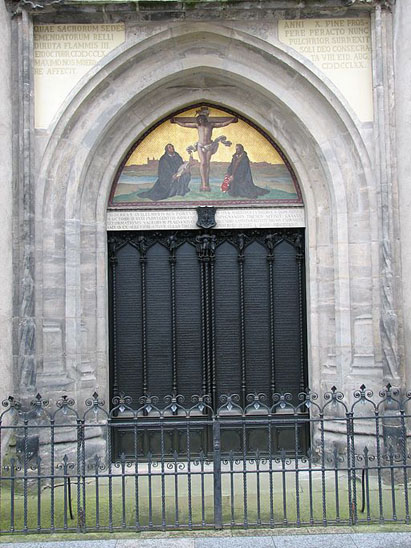Even though the Roman Catholic Church dominated religious life in Europe beginning in the 10th century, it did not meet with universal approval. Over the centuries, rulers, scholars and some members of the clergy were critical of church practices despite many important church reforms. With the advent of the Renaissance and the invention of the printing press, new forces began to weaken church authority. Additionally, the new wealthy merchant class resented paying church taxes to Rome, and rulers were less willing to have the pope exert power over them. These were the social and political conditions that existed when Martin Luther posted his 95 Theses to the All Saints’ Church door in Wittenberg, Germany, on October 31, 1517.
Read the passage below about Martin Luther.
Martin Luther and the 95 ThesesMartin Luther and the 95 Theses
Born in Eisleben, Germany, in 1483, Martin Luther became one of western history's most significant and influential figures. His father was a prosperous businessperson who wanted his son to attend university to become a lawyer. In 1501, Luther enrolled in the University of Erfurt, the best university in Germany at the time, and he earned a Master's degree. In 1505, Martin Luther entered an Augustinian monastery, wanting to be a good Christian more than a lawyer. He continued his university studies and earned a doctorate in biblical studies.
Over the next five years, Luther began questioning the teachings of the Catholic Church. In 1517, he decided to take a stand against Johann Tetzel, a priest who was selling indulgences, or pardons, for sins in Germany in order to renovate St. Peter's Basilica in Rome. Indulgences replaced the penalty imposed by a priest for sins. Tetzel was also giving people the impression that they could buy their way into heaven with the purchase of indulgences.
In response to the actions of Tetzel, Luther posted the 95 Theses, or formal statements, attacking the practice of selling indulgences. The 95 Theses were posted on the door of the castle church in Wittenberg on October 31, 1517, inviting other scholars to a debate. Because people copied Luther's words and gave them to a printer, Luther became famous in Germany in very little time. Soon Luther went beyond criticizing the selling of indulgences to calling for complete reform of the Catholic Church. His actions started the Reformation, a movement for religious reform of the Catholic Church. The Reformation led to the founding of other Christian churches that did not accept the authority of the pope. These churches were known as Protestant churches because they were founded in protest of the Catholic Church.
Luther's teachings included:
• The Bible is the main source of religious authority rather than the pope.
• Since all people are equal, the Bible should be translated and made available to everyone; people did not need priests to interpret it for them.
• Salvation is achieved through faith in God's forgiveness alone, rather than faith and good deeds as taught by the Catholic Church.
After reading the excerpt, watch this video that takes you through the processes of identifying the author’s central idea or claim and citing evidence used in the text to support the claim.
In the text about Martin Luther, there was one central idea. However, it is important to note that in many texts, it is necessary to identify the central idea in each paragraph and combine these central ideas to discover the central ideas for the entire passage or document. You will practice this skill later in the module.









